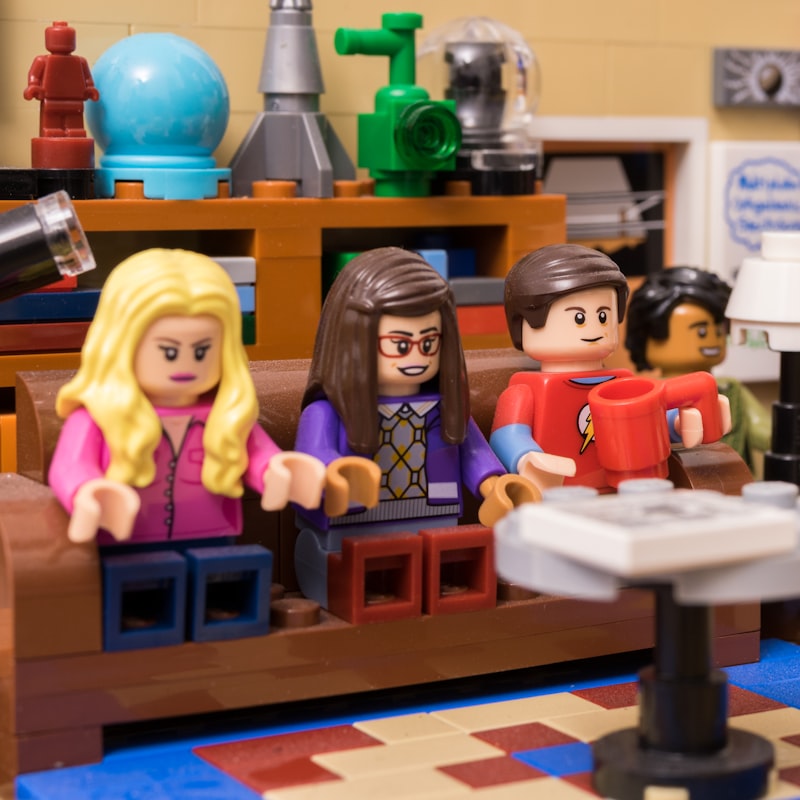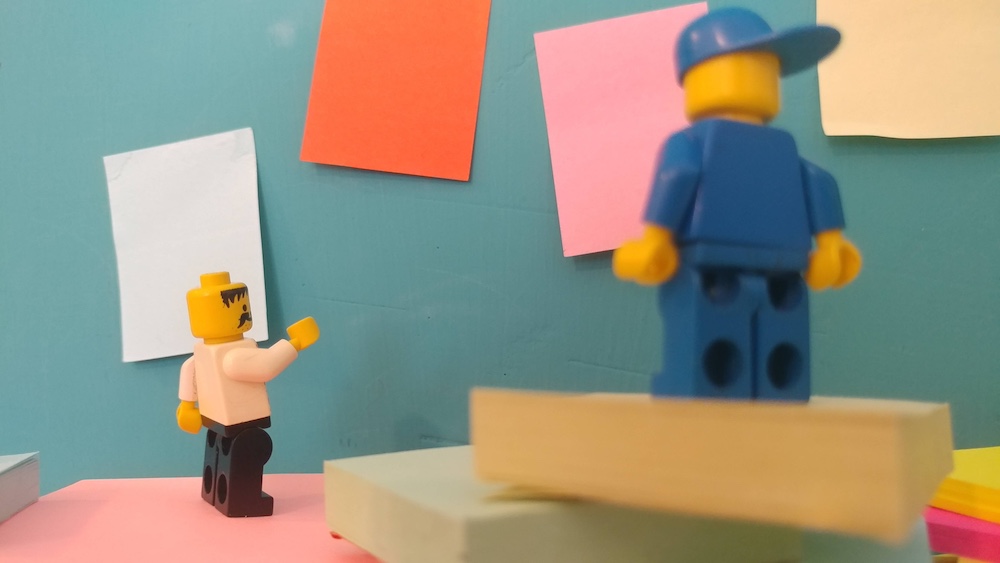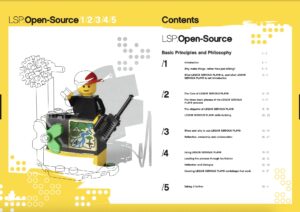You may have seen a workshop done with LEGO® pieces in an organization. There is a specific methodology for using these bricks, blocks, and characters in training or learning and development programs. LEGO® Serious Play® is a facilitation methodology that resonates with me. It’s an approach that can make a workshop or training experience highly engaging, interactive, reflective, collaborative, and memorable. All elements I’m focused on in the L&D experience I develop.
As someone deeply passionate about metaphor, story making, and storytelling, LEGO® Serious Play® (LSP) is a method that connect with me on a profound level. The structure of starting with individual insights and then moving to group discussions (all while creating something) aligns perfectly with my style of working. This method captures the essence of how I believe teams should interact – through personal reflection and creating leading to collective sharing and understanding.
Why I Think LEGO® Serious Play® Stands Out
Metaphor and Storytelling
LSP leverages the power of metaphor and storytelling, allowing participants to build and share their ideas through tangible models. This approach not only makes abstract concepts concrete but also ensures that every participant’s voice is heard and valued. The process of creating individual models first, and then integrating them into a collective “super-story,” helps visualize how individual perspectives contribute to the larger picture. This method fosters deeper conversations and helps teams understand how different ideas and insights fit together.
Effective Learning and Development
During my certification in the method, I was pleasantly surprised with how intentional, systematic, and rigorous the approach is. It’s not just throwing a bunch of bricks on a table. It’s built on learning and development (and facilitation) research and best practices. There is an open source guide that dives deeper on this. There have been hundreds of facilitators experimenting with this method and sharing there insights to build the knowledge base.
Super Story and Landscape
One of the most compelling aspects of LSP is the transition from individual models to a collective representation. This “super-story” technique encourages participants to integrate their individual contributions, generating richer discussions and a holistic view of the team’s insights and ideas. This step is crucial for deeper understanding and team alignment.
Personal Experience and Reflection
I vividly recall a workshop I led for a global organization where most of the participants traveled to the US from another country. A key activity to get started focused on designing a culture of innovation for a partner at your table. The “hands-on, minds-on” approach of building from the blocks made the session incredibly effective and memorable. Participants built models that represented their stories, goals, and organizational values, which facilitated ongoing communication and collaboration.
Here’s a guide we’ve developed for you to help you learn more about this approach for training, workshops, onboarding, L&D programs, or any other application you can think of. We will view this through the lens of innovation, problem solving, or leadership development programs though you can use the approach in many different settings.
Lego Workshops for Organizations and Business Guide

1. Introduction to Workshops with LEGO® Serious Play®
Overview of LEGO® Serious Play®
LEGO® Serious Play® (LSP) is an innovative, experiential process designed to enhance learning, innovation and performance in a workshop or training experience. Developed by the LEGO® Group, this method harnesses the power of LEGO® bricks to unlock creative thinking and problem-solving skills. Participants use LEGO® bricks to build models that represent their ideas, reflections, and solutions. This hands-on, minds-on approach enables deeper insights, fosters collaboration, and facilitates effective communication.
Origins and Development
LEGO® Serious Play® originated from the LEGO® Group’s internal needs to innovate and solve problems creatively. The process evolved from the concept of ‘thinking with your hands,’ where building models with LEGO® bricks helps externalize thoughts and ideas, making abstract concepts tangible and easier to explore and discuss. Over the years, LSP has been adopted globally, proving its efficacy in various sectors including business, education, and non-profits.
2. Core Principles of LEGO® Serious Play®
The Philosophy Behind LSP
The philosophy of LEGO® Serious Play® is built on several core principles:
- The Answer is in the System: LSP encourages participants to tap into collective intelligence. The process is designed to ensure that everyone’s insights are considered, promoting a holistic understanding of the challenges and opportunities.
- Everyone Builds and Shares: All participants build their models and share their stories. This democratizes the process, giving everyone a voice and ensuring diverse perspectives are represented.
- Asking the Right Questions: The facilitator’s role is crucial in guiding the process through open-ended questions that encourage reflection and deeper thinking.
Values and Etiquette
To ensure the integrity and effectiveness of LSP workshops, participants adhere to specific values and etiquette:
- Equal Participation: Every participant is given equal opportunity to build and share.
- Focus on the Model: The meaning of each model is determined by its builder. Others may ask questions but should not impose their interpretations.
- Listen with Your Eyes: Participants are encouraged to observe models closely, enhancing their understanding and empathy.
- Facilitator’s Role: The facilitator guides the process, ensuring adherence to principles and encouraging reflective and open dialogue.
3. Applications of LEGO® Serious Play®
Business and Organizational Development
LSP is widely used in businesses to address various challenges, including strategy development, team building, and innovation. It helps organizations unlock their potential by facilitating meaningful dialogue and collective problem-solving.
The LSP process uses LEGO® bricks to visualize complex business situations and enhance performance. These bricks serve as metaphors for real business challenges, allowing teams to address intricate issues without oversimplifying them. Backed by substantial research, LSP’s methodology engages teams through storytelling, ensuring continuous dialogue and a deeper exploration of ideas.
After initial introductions and warm-up activities, team members construct models in response to specific questions. Four of my favorites are:
- What strengths do you bring to the team?
- What is your unique contribution that no one knows about?
- Which organizational value resonates most with you, and why?
- What major goals do you aim to achieve within the team?
Education and Learning
In educational settings, LSP enhances engagement and learning by making abstract concepts concrete. It encourages active participation, critical thinking, and collaborative learning among students or staff. One memorable activity is the “1-minute DUCK” exercise, which showcases creative thinking. Using the same six blocks, participants create different versions of a duck within one minute, demonstrating the numerous possibilities and perspectives within a team. Transforming the duck into something that represents a personal strength further emphasizes individual contributions to the team.
Community and Social Innovation
LSP is also effective in community and social innovation projects. It brings diverse stakeholders together, fostering inclusive dialogue and co-creation of solutions for community challenges. Many of the elements you’ve read above can be used in community or service groups, especially when the groups form.
4. Workshop Structure
Typical Workshop Flow
A standard LSP workshop involves several stages:
- Skills Building: Participants familiarize themselves with LEGO® bricks through simple building exercises, enhancing their comfort and creativity.
- Core Identity: Participants build models representing their core identity within the context of the workshop.
- Shared Model: Participants collaborate to create a shared model that integrates their individual models, reflecting the collective understanding of the group.
Duration and Group Size
Workshops typically last from a few hours to a full day, depending on the objectives. Optimal group size ranges from four to eight participants, ensuring active participation and effective dialogue.
5. Techniques in LEGO® Serious Play®
Building Challenges
Building challenges are open-ended questions posed by the facilitator. These questions guide participants to build models that represent their thoughts, feelings, and ideas. Examples include:
- “Build a model that represents your vision for the team’s future.”
- “Create a model that shows the current challenges your organization faces.”
Reflection and Sharing
After building, participants share the stories behind their models. This reflection phase allows for deeper insights and understanding. The facilitator asks probing questions to encourage further exploration.
6. The Facilitator’s Role
Guiding the Process
The facilitator is key to the success of an LSP workshop. They guide the process, ensure adherence to principles, and ask open-ended questions that stimulate reflection and dialogue. Their role is to create a safe and inclusive environment where all participants feel comfortable sharing their ideas.
Preparing for a Workshop
Facilitators prepare by designing building challenges that align with the workshop’s objectives. They also set up the physical space to ensure a conducive environment for building and sharing.
7. Tools and Materials
LEGO® Sets
Specific LEGO® sets are designed for LSP workshops, including the Starter Kit, Identity and Landscape Kit, and Connections Kit. These sets contain a variety of bricks and elements that facilitate creative expression and metaphorical thinking.
Workshop Setup
A typical setup includes a table for each group, ample space for building and displaying models, and a comfortable environment that encourages collaboration and focus.
8. How to Get Started with LEGO® Serious Play®
Training and Certification
Aspiring facilitators can undergo training and certification programs to master the LSP methodology. These programs provide hands-on experience and deep insights into effective facilitation techniques. There are a wide variety of online and in-person programs across the globe.
Running Your First Workshop
Start with a small, low-stakes workshop to build your confidence and skills. Invite friends or colleagues to participate and provide feedback. Gradually scale up to more complex and high-stakes workshops as you gain experience. Bring in a certified facilitator to help.
8. Frequently Asked Questions
What is the ideal group size for an LSP workshop?
The ideal group size is between four and eight participants. This ensures active participation and effective dialogue.
How long does an LSP workshop last?
Workshops can range from a few hours to a full day, depending on the objectives and complexity of the challenges being addressed.
Do participants need prior experience with LEGO® bricks?
No prior experience is necessary. The initial skills-building exercises help participants get comfortable with the bricks.
10. Contact and Custom Workshops
For a customized LEGO workshop tailored to your organization’s needs, feel free to contact us. We offer bespoke workshops designed to address specific challenges and objectives, ensuring maximum impact and value.
This guide provides a comprehensive overview of LEGO® Serious Play®, its principles, applications, and techniques. By following this guide, you can effectively engage your team in a LEGO workshop that can drive innovation, enhance collaboration, and solve complex challenges.
LEGO workshops Conclusion
LEGO® Serious Play® is a powerful tool for unlocking creativity, fostering collaboration, and solving complex problems. Its emphasis on metaphor, storytelling, and hands-on engagement aligns seamlessly with my approach to learning and development. This method not only brings out the best in individuals but also integrates their insights into a cohesive and innovative team dynamic. We are excited to share this guide and offer customized workshops to help organizations harness the full potential of LEGO® Serious Play®. Just reach out to learn more.

